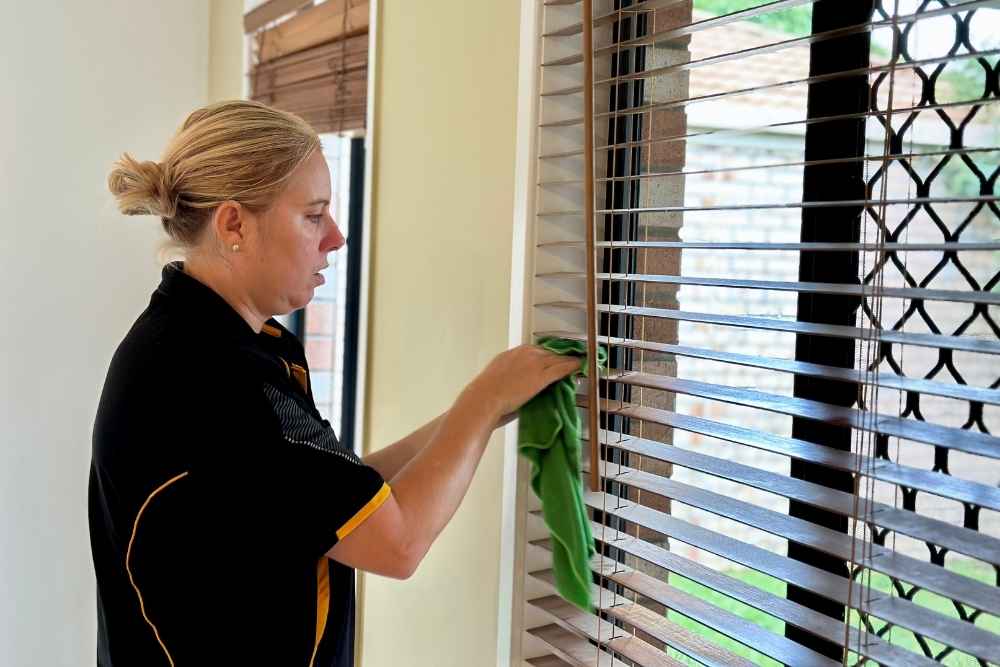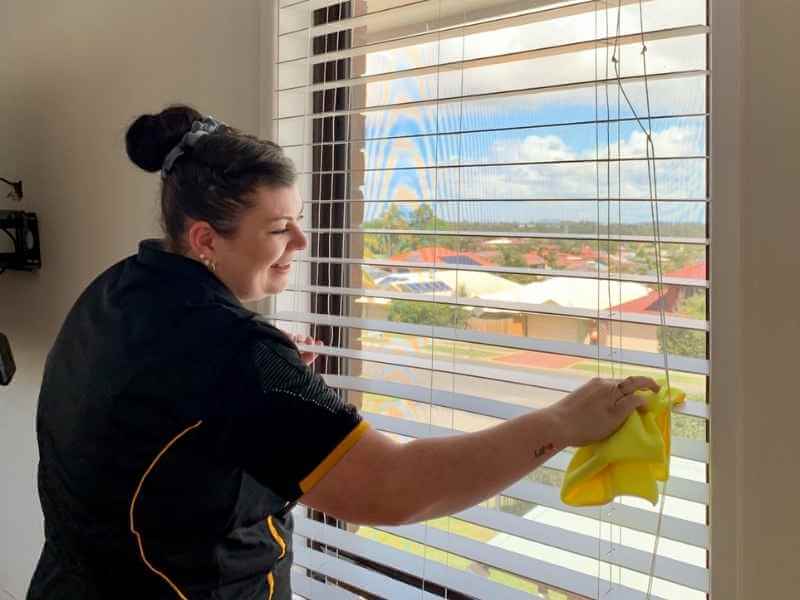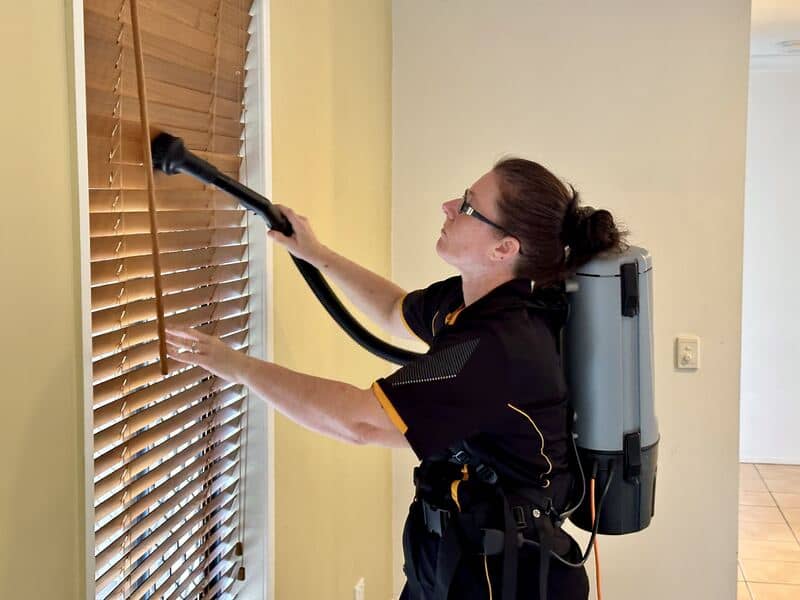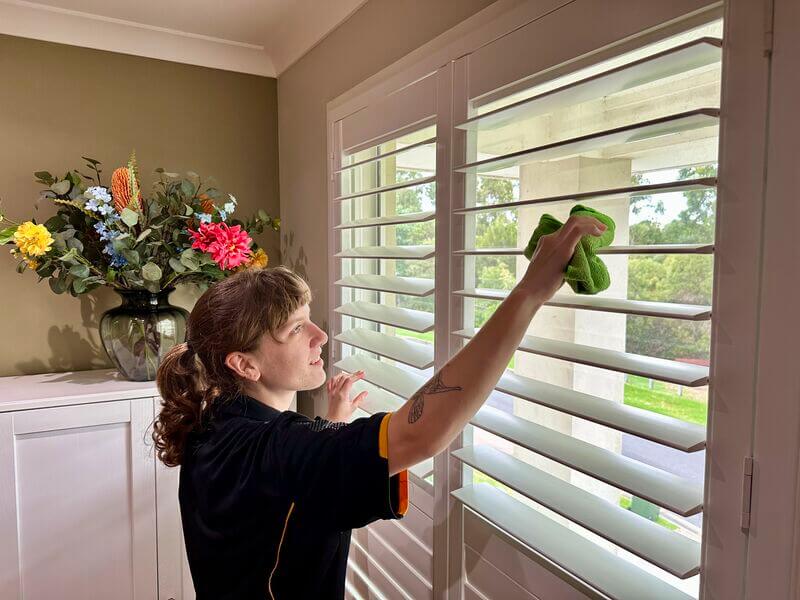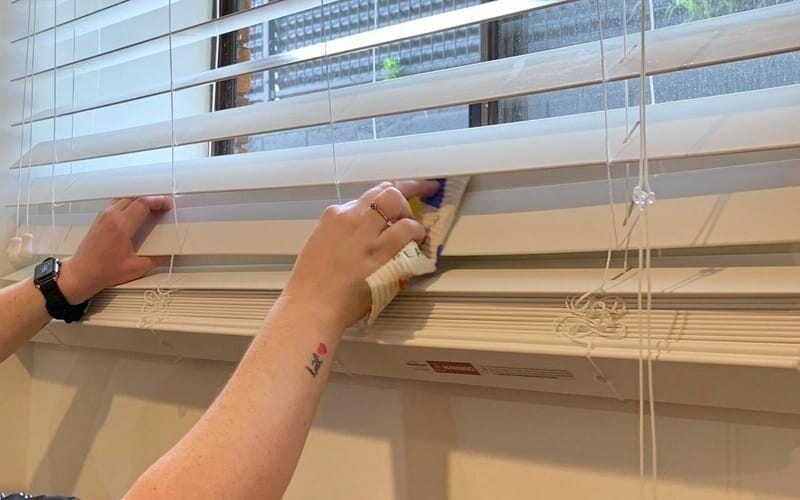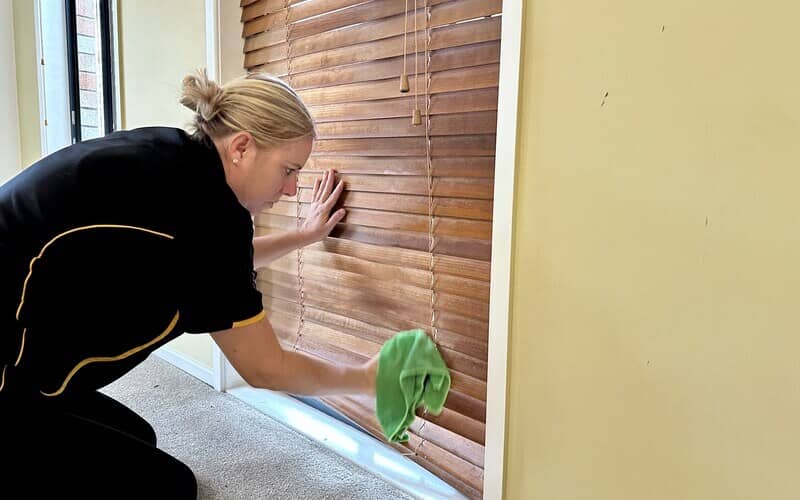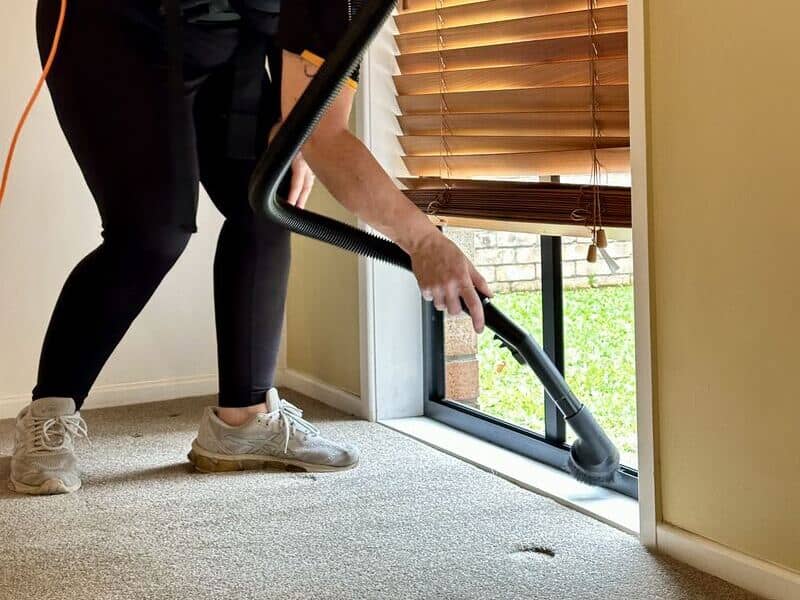You’re enjoying a quiet afternoon when a sunbeam hits your blinds. Oops… how long have they been covered in grime?
Blinds are often the last thing we think of cleaning. But keeping them neat is simple if you stay on top of routine care.
For regular dusting, you don’t need to take your blinds down — just grab a microfibre cloth and a vacuum cleaner.
But for a proper deep clean, you may need to unmount your blinds.
We’ll tell you how to clean blinds (of all types and materials!) so your space looks fresh and polished.
Honeycomb Blinds | Plantation Shutters | Roller Blinds | Roman Blinds | Venetian Blinds | Vertical Blinds
How Often Should You Clean Your Blinds?
Regular upkeep will help keep your window coverings looking like new!
Here’s how often to clean your blinds:
- As needed: Spot clean stains as soon as you see them
- Every 1–2 weeks: Dust your blinds while they’re hanging
- Every 1–2 years: Unmount your blinds for a thorough deep clean
Keep in mind that you might need to clean your blinds more often if they’re in a humid area, like the bathroom and kitchen.
If it all feels overwhelming, don’t hesitate to get some help from housekeeping professionals!
Before Cleaning Your Blinds
If your blinds have a care tag or manual, read it for specific cleaning instructions.
It’s also worth learning how to take your blinds down in case a deep clean is needed.
Before using any cleaner, spot test it on a small, hidden area to check for damage or discolouration.
Do not use harsh chemicals and abrasive tools on your blinds! These can scratch or ruin the finish.
Finally, consider the material you’re working with to preserve the quality and keep your blinds in great shape.
Blind Cleaning Tips by Material
Window blinds come in all sorts of materials, and each needs a slightly different cleaning method.
FABRIC BLINDS: Check the care label to confirm if they’re washable. Dry thoroughly after cleaning to avoid water rings.
FAUX WOOD BLINDS: Made from PVC or composite blends to mimic real wood. They handle moisture quite well and are safe to clean with a damp cloth.
METAL BLINDS: Durable but prone to rust and water spots if soaked. Stick to a damp cloth for cleaning, and dry them right away.
VINYL OR PVC BLINDS: Tough and low maintenance. These can usually be soaked in warm, soapy water for a deeper clean.
WOODEN BLINDS: Too much moisture can damage wood, so use as little water as possible. Opt for a wood-safe oil soap when removing stains.
What You Need to Clean Your Blinds
You can clean window blinds using a few everyday items. Gather these before getting started:
- Dish soap
- Feather duster
- Microfibre cloth
- Vacuum cleaner with a soft brush attachment
Wear a pair of gloves and a mask for extra protection, especially if you have a dust allergy!
Cleaning Different Types of Blinds
For regular upkeep, you can clean your blinds without taking them down. Just be sure to extend them fully so you can dust each slat thoroughly.
Always make sure that the blinds are completely dry before closing or rolling them back up.
How to clean honeycomb blinds
Honeycomb blinds (or cellular shades) have a pleated fabric that forms air pockets or “cells” that look like a honeycomb.
They’re great for insulation, but the cells can trap dust and even dead bugs!
To clean honeycomb blinds, use compressed air to blow out debris from inside the cells. A hair dryer on the cool setting can also work.
Next, run a vacuum with a soft brush attachment across the surface. Go from left to right, starting from the top.
Finally, spot clean any stains with a cloth dampened with soapy water. Remove any soap residue with another damp cloth.
If your honeycomb blinds need to be deep-cleaned, it’s best to take them to a professional. Do not soak them as this can ruin the fabric structure.
How to clean plantation shutters
Plantation shutters (or shutter blinds) come in a range of materials — aluminium, faux wood, vinyl, and real wood.
Their horizontal slats can collect dust quickly, so regular dusting is a must.
The best way to clean shutter blinds is with a feather duster or a microfibre cloth.
Tilt the slats slightly open, then remove dust from both sides of each slat, working from top to bottom.
Don’t forget to dust the windowsill and the shutter frame, too.
Next, spot clean stains using a cloth dampened with soapy water. Follow with a clean, damp cloth to mop up any residue.
Leave the shutters open to air dry.
If your shutters are very grimy, you might need to take them down for a deeper clean.
For most types, a damp cloth with a bit of dish soap will do the trick. If you’re cleaning wooden shutters, be sure to use water sparingly.
How to clean roller blinds
Roller blinds are usually made from a single sheet of fabric or vinyl. This simple design makes them easy to maintain!
To clean roller blinds, use a vacuum cleaner with a soft brush attachment. Run it over the sheet gently — be sure to cover the entire surface.
Next, lightly scrub any stains with a cloth dipped in soapy water. Wipe the area with another damp cloth to get rid of leftover soap.
Vinyl blinds can be left to air dry. For fabric blinds, use a hair dryer on the lowest setting to dry damp spots quickly.
When deep cleaning roller blinds, it’s best to stick to spot cleaning. Heavily soiled blinds can be washed in the tub, but only if the care label says it’s safe!
How to clean Roman blinds
Roman blinds are usually made from delicate fabrics like linen or silk, so stick to gentle cleaning methods!
For regular dusting, you can use a vacuum with a soft brush attachment on your Roman blinds.
Gently go over the fabric while supporting it with your hand from behind.
Next, spot clean stains — but only if your blinds are washable. If it’s safe, dab the stains with a damp cloth and soapy water.
Blot any excess moisture with a clean cloth. Then, dry the area right away with a hair dryer on a cool setting.
For a deeper clean, some Roman blinds can be hand-washed, while others may need dry cleaning.
If hand washing is safe, use mild detergent and follow the recommended water temperature on the care label.
Do not scrub, wring, or twist the blinds to avoid damaging the material and shape.
How to clean Venetian blinds
Venetian blinds have horizontal slats that can be tilted to any angle. They can be made from aluminium, faux wood, vinyl, or real wood.
To clean Venetian blinds, close the slats first.
Dust each slat using a feather duster or a vacuum cleaner with a soft brush attachment. Start at the top and work your way down.
Next, spot clean any stains with a damp cloth and soapy water. Wipe off any residue with another damp cloth, then dry the area.
Afterwards, close the blinds the other way and repeat the steps.
For a deeper clean, unmount the Venetian blinds.
Use a damp cloth for aluminium and faux wood. On the other hand, vinyl blinds can usually be soaked in warm, soapy water.
For wooden Venetian blinds, use as little water as possible when wiping to protect the finish!
How to clean vertical blinds
The best way to clean vertical blinds is with a microfibre cloth and a vacuum cleaner with a soft brush attachment.
To start, tilt the slats slightly open. Hold a microfibre cloth behind one slat. With your other hand, gently vacuum down the front.
Slowly move both hands down together, so you’re cleaning both sides at once while supporting the slat from behind.
Once all slats are dust-free, spot clean stains with a damp microfibre cloth and warm, soapy water. Wipe off any residue with a clean, damp cloth.
For a deeper clean, vinyl blinds can usually be soaked in the tub.
With fabric blinds, always check the care label first. Some can be hand- or machine-washed, while others are dry-clean only.
How to Remove Stains From Blinds
When removing stains from your blinds, always spot test the cleaning solution on a hidden area first.
For fabric blinds, dab the stain gently — don’t rub to avoid spreading it or pushing it deeper.
On wooden blinds, opt for a wood-safe oil soap to protect the finish. Be sure to follow the product’s instructions carefully.
Always wipe off any residue from the stain remover with a damp cloth, then dry the area thoroughly.
Food stains
To remove food stains from blinds, mix a few drops of dish soap with warm water.
Dip a microfibre cloth into the solution, and gently dab the stain. Once the mark is gone, wipe off any residue with a clean, damp cloth.
Ink stains
To remove ink stains from blinds, try rubbing alcohol.
Apply a small amount onto a cotton pad, then gently blot the ink stain until it fades.
Mould
To clean mould off blinds, mix equal parts white vinegar and water in a spray bottle.
Apply the vinegar solution to the affected area, and let it sit for an hour. Then, gently wipe the mouldy spots with a damp cloth.
If the mould grows back, use a stronger vinegar solution or 3% hydrogen peroxide (if safe for the material)!
Water stains
Water stains can form on the surface of blinds if they didn’t dry properly. Hard water or leftover cleaning products can also leave marks.
To get rid of them, mix equal parts white vinegar and distilled water.
Lightly spray the stained area with vinegar solution, and let it sit for 5–10 minutes.
If you’re working with fabric blinds, blot the excess moisture with a clean cloth. Then use a hair dryer on the cool setting for faster drying.
For other types of blinds, wipe off any remaining vinegar solution with a damp cloth. Then dry the area with a clean cloth.
More Tips to Keep Your Blinds Clean
To keep your blinds fresh and spotless, stick to your cleaning routine (even when it feels like a chore!).
Regular dusting and spot cleaning are far easier than doing a massive, deep clean later on.
Be sure to wipe down nearby surfaces like walls and windows often. If you have curtains over your blinds, keep those clean too.
All that can lessen the amount of dust that ends up on your blinds.
Finally, keep your home well-ventilated to prevent mould from growing on your window covers.
FAQs: More Cleaning Tips for Your Blinds
Still have questions? Here are more handy tips to keep your blinds spotless!
What is the best way to clean blinds without taking them down?
The best way to clean blinds without taking them down is to use a vacuum cleaner with a soft brush attachment.
A feather duster and a microfibre cloth can work, too.
If you have horizontal blinds (like Venetian), you can use a blinds duster that can clean multiple slats at once!
Can you use vinegar to clean blinds?
Yes, vinegar is a gentle cleaner that works well on most blinds to remove stains and kill mould. Here’s how to use it:
- For stuck-on grime: Mix 1 part vinegar with 3 parts water
- For mould and water marks: Use a 1:1 mix of vinegar and water
If you have fabric blinds, always make sure they’re washable before applying a vinegar solution.
Can I soak blinds in a tub?
It depends on the material. Vinyl and PVC blinds can usually be soaked in warm, soapy water for a deeper clean.
Be sure to remove or keep any metal parts out of the water to prevent rust.
For aluminium and faux wood blinds, it’s best to avoid soaking altogether to avoid any damage. Stick to wiping them down with a damp cloth.
Wooden blinds should never be soaked. Too much moisture can cause wood to warp.

